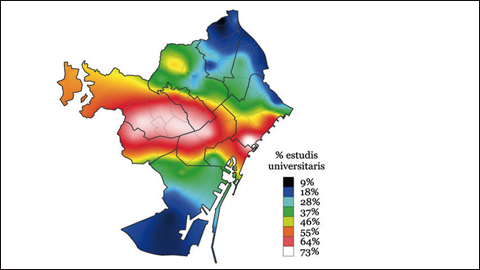Barcelona attracts talent but does not distribute it equally

18/07/2016
A study conducted by the Centre for Demographic Studies (CED) of the Universitat Autònoma de Barcelona (UAB), published today in the journal “Perspectives Demogràfiques” (July 2016, n.3), provides new evidence on the territorial segregation of the city of Barcelona in an article entitled “Barcelona’s Got Talent: Migration, Residential Change and Socioeconomic Polarisation”.
The study emphasises the key factors of residential mobility and migrations as mechanisms which accentuate socioeconomic differences in the city.
The data reveals that Barcelona is a powerful pole of attraction for highly qualified young professionals. Some 80,000 people arrived yearly to the city of Barcelona during the 2011-2014 period. A total of 45% of these people came from other parts of Catalonia, 35% from other countries and 20% from other parts of Spain. Half of the population from 25 to 39 are university graduates (43% of men and 55% of women), a proportion which has grown since first starting the study (in 2014 it reached 47% among men and 58% among women).
The population of foreign nationals coming from other parts of Catalonia and Spain is the one with the lowest level of education, with 30% of young adults holding university degrees.
In contrast, over 65% of the young adult population originating from other parts of the world, and Spanish nationals coming from other parts of Spain, hold a university degree.
Compared to the rest of metropolitan municipalities, 56% of the population aged 25 to 39 and who arrived in the municipality of Barcelona between 2007 and 2011 had completed higher education, while only 32% of people with the same educational level went to other municipalities of the metropolis.
Choosing Neighbourhoods
Barcelona has all the power to attract a qualified population, but no power to distribute it evenly throughout the city. Spanish nationals are largely concentrated in the neighbourhood of Gràcia, although they can also be found in the neighbourhoods of Eixample, Sants-Montjuïc, Les Corts, Sarrià-Sant Gervasi and Sant Martí. Foreign nationals who have completed higher education are predominantly found in the Ciutat Vella district.
The neighbourhoods furthest from the centre of the city stand out as areas in which education levels are lower: the districts of Nou Barris and Horta-Guinardó, the neighbourhoods next to the Besòs River, and the neighbourhoods of La Marina de Port and La Marina del Prat Vermell, Sants-Montjuïc. There are also many foreign nationals living in the neighbourhoods of Raval and Poble Sec.
The population of university degree holders who move from a lower-income neighbourhood are twice as likely to take up residence in a higher-income neighbourhood than those with no higher education (60% vs. 30%). The higher the education level, the less likely the person will take up residence in a lower-income neighbourhood. In contrast, the probabilities of moving to a higher-income neighbourhood increases together with education level in groups from all neighbourhoods.
This is fueling the socioeconomic polarisation process within the city of Barcelona, as has happened in other European cities.
The attraction of highly-qualified professionals affects the housing market, which can be noticed in a recent increase in prices in the sectors with a high demand.
The experience of other cities which specialised in attracting highly qualified professionals demonstrates that housing in specific sectors of the city has become exclusive (and excluding) and that this area of exclusion expands to other central neighbourhoods, generating a progressive suburbanisation of poverty.
Author of the study Antonio López Gay explains in the article that “for Barcelona not to die of success, it must follow a model which incorporates redistributive policies of the benefits generated by attracting qualified populations; the metropolitan articulation of these policies is essential”.
ORIGINAL ARTICLE: López-Gay, Antonio: "Atracció de talent i polarització socioeconòmica a Barcelona”, Perspectives Demogràfiques, num. 3, July 2016.